The Wondrous World of Waffles
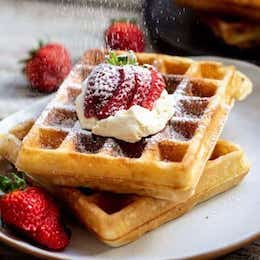
According to a study done by General Mills, waffles are the second most popular breakfast food after pancakes, with 45% of American’s breakfast eaters claiming waffles are their go-to dish. In fact, waffles are so well liked in this country that a host of restaurants have built their entire menus around them, the largest being Waffle House. With almost 2000 locations in 25 states, Waffle House is said to serve around 145 waffles every minute of every day. And that my friends is one hell-of-a-lot of waffles.
Middle Age Origin
The origin of waffles can be traced back to ancient Greek flat cakes called “obelios,” cooked by Athenians in open hearth fires between two round iron plates connected to long wooden handles. These first cakes, later known as wafers, were made only from grain flour, water, and sometimes milk and eggs.
 By the 13th century people began embellishing the iron plates used for cooking wafers with elaborate designs of all sorts—biblical scenes, including Jesus and his crucifixion, family crests, landscapes, even simple geometric patterns. It was also about this period that spices and flavorings, made available as a result of The Crusades, were being added to obelios batters, making them more tasty and satisfying.
By the 13th century people began embellishing the iron plates used for cooking wafers with elaborate designs of all sorts—biblical scenes, including Jesus and his crucifixion, family crests, landscapes, even simple geometric patterns. It was also about this period that spices and flavorings, made available as a result of The Crusades, were being added to obelios batters, making them more tasty and satisfying.
Wafers (also called as “walfres”) had grown so popular by the 14th century that they became a popular street food hawked by venders known as waferers in England and gaufriers in France. In order to maximize sales on holy days these venders would set up booths just outside the church doors furnished with everything needed to offer their wares freshly baked and hot. Unfortunately, such were their numbers that chaos would often ensue among them. This resulted in laws being passed that established boundaries and limitations on their booths.
It was also during this period that the first known waffle recipe was written, penned in the anonymous manuscript, Ld Ménagier de Paris by a husband as instructions to his young wife on how to make this special treat:
“Beat some eggs in a bowl, season with salt and add wine. Toss in some flour, and mix. Then fill, little by little, two irons at a time with as much of the pate as a slice of cheese is large. Then close the iron and cook both sides. If the dough does not detach easily from the iron, coat it first with a piece of cloth that has been soaked in oil or grease.”
The manuscript also contained three variations of this gaufre (waffle) recipe—one on how the cheese was to be placed between two layers of bater, one on how to add grated cheese into the batter itself, and one leaving out both the cheese and the eggs.
 Sometime around the 15th century, the Dutch, for reasons long forgotten, abandoned the round iron plates used to cook their wafeles in favor of rectangular irons. These new Dutch irons also featured a shallow grid design similar to what we are familiar with today. They employed long metal handles with wooden grips designed for use over open hearth fires.
Sometime around the 15th century, the Dutch, for reasons long forgotten, abandoned the round iron plates used to cook their wafeles in favor of rectangular irons. These new Dutch irons also featured a shallow grid design similar to what we are familiar with today. They employed long metal handles with wooden grips designed for use over open hearth fires.
This century also brought about other waffle firsts. The recipe Om geode waffellen the backen from the Dutch manuscript KANTL 15 is only the second known waffle recipe and the first in which partial ingredient measurements were given. It is also the first recipe where sugar was used and spices were added to the batter. It should also be noted that waffles in this century was usually for desserts and snacks, never for breakfast.
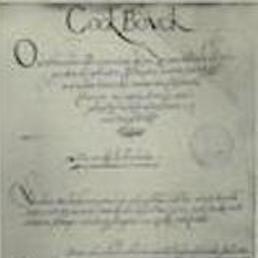 In 16th and 17th centuries, Belgium saw the publication of Een Antwerps kookboek which contained the recipe Groote Wafelen, which was the first recipe to use leavening in the form of beer yeast:
In 16th and 17th centuries, Belgium saw the publication of Een Antwerps kookboek which contained the recipe Groote Wafelen, which was the first recipe to use leavening in the form of beer yeast:
“Take white flour, warm cream, fresh melted butter, yeast, and mix together until the flour is no longer visible. Then add ten or twelve egg yolks. Those who do not want them to be too expensive may also add the egg white and just milk. Put the resulting dough at the fireplace for four hours to let it rise better before baking it.”
It is said that Groote’s recipe, with its use of leavening was the origin of contemporary waffles.
Waffles in America
Waffles were brought to America in 1620 by the Pilgrims who sampled them in Holland before making their trip across the ocean. However, it was the Dutch immigrants of New Amsterdam (what’s now New York City) who, with their irons and recipes, popularized waffles here in this country.
The first American waffle recipe was published in Robert Smith’s 1725 cookbook, Court Cookery. And although derived almost directly from Dutch recipes, it was the first time two f’s were used in the spelling the word “waffle.”
“Waffles
Take Flower, Cream, Sack, Nutmeg, Sugar, Eggs, Yest, of what Quantity you will ; mix these to a Batter, and let the stand to rise ; then add a little melted Butter, and bake one to try ; if they burn, add more Butter : Melt Butter, with Sack, refin’d Sugar, and Orange-Flower Water, for the Sauce.”
 Returning home in 1789 from his time as ambassador to France, Thomas Jefferson brought with him America’s first goose-handled waffle iron and a number of recipes. While functionally similar to existing long-handled irons, it is said to have helped popularized the waffle to the American upper-class. Some historians also feel it was this advent that sparked the American fad known as “Waffle Folics,” a fad that continued for almost two centuries, whereby the host would serve guests a variety of dishes featuring waffles. So popular were these frolics, that an article published in the early 20th century magazine What to Eat provided complete instructions on how to throw the popular waffle event—from making invitations, to involving the guests, to accompaniments, and other foods to serve.
Returning home in 1789 from his time as ambassador to France, Thomas Jefferson brought with him America’s first goose-handled waffle iron and a number of recipes. While functionally similar to existing long-handled irons, it is said to have helped popularized the waffle to the American upper-class. Some historians also feel it was this advent that sparked the American fad known as “Waffle Folics,” a fad that continued for almost two centuries, whereby the host would serve guests a variety of dishes featuring waffles. So popular were these frolics, that an article published in the early 20th century magazine What to Eat provided complete instructions on how to throw the popular waffle event—from making invitations, to involving the guests, to accompaniments, and other foods to serve.
Waffle Iron Innovations
On August 24, 1869, Cornelius Swartwout of Troy, New York, received a patent on his “Improvement in Waffle-Irons.” Although waffle irons existed as early as the 1300s, Swartwout’s innovative design shortened the handles and added a clasp that enabled waffle makers to 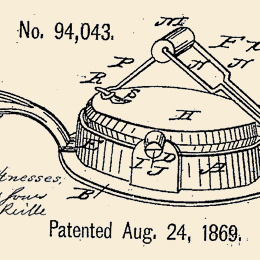 flip the iron on the cooktop of their wood burning stoves without the risk of burning themselves. Here is how Swartwout himself describes his innovation in the patent application:
flip the iron on the cooktop of their wood burning stoves without the risk of burning themselves. Here is how Swartwout himself describes his innovation in the patent application:
“The nature of my invention consists in providing a handle, connected with and forming part of a waffle-iron, by means of which the same may be readily turned over without danger of slipping, and without the possibility of burning the hand.
 It also consists in providing a device, by means of which the upper or covering portion of a waffle-iron may be raised, so as to expose the interior, for filling or for removing the waffle when done, without danger of the cover slipping back, and without burning the hand.”
It also consists in providing a device, by means of which the upper or covering portion of a waffle-iron may be raised, so as to expose the interior, for filling or for removing the waffle when done, without danger of the cover slipping back, and without burning the hand.”
Swartwout’s waffle iron innovations quickly brought waffles into the mainstream of America’s households. So much so that cookbooks far and wide began including waffles as an easy, inexpensive breakfast option. This 1885 recipe by Lafcadio Hern with its lack of flavor ingredients stresses not the waffles taste, but its low cost:
“Waffles, Economical Way
Take two eggs, a cup of sweet milk, one cup of water and three cups of flour, with two tablespoons of yeast powder mixed in it before sifting; add a tablespoon of melted lard or butter, and a teaspoon of sugar. Mix all well, and bake in waffle irons. This is a nice cheap waffle.”
However the rapid growth of the stovetop waffle iron brought with it many more recipes in a wide variety of home management and cook books—recipes aimed at the novice waffle cook, detailing both measurements and cooking times.
In honor of Cornelius’ contribution to the American kitchen, August 24th has been declared as National Waffle Day.
Twentieth century America brought home electrification, and with it the introduction of the electric waffle iron. Around the year 1900, both Westinghouse and General Electric had produced prototypes of their electric waffle irons, but they were primitive and unsuccessful since the technology of heating elements was still very young. It would be the Simplex Electrical Heating Company of Boston, 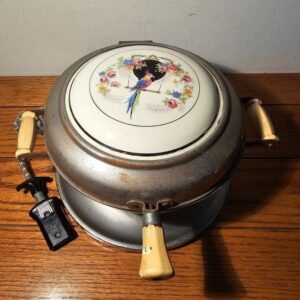 Massachusetts who, in 1906, produced the first commercially successful electric waffle iron.
Massachusetts who, in 1906, produced the first commercially successful electric waffle iron.
By the 1920s both General Electric and Landers, Frary and Clark had produced electric waffle irons suitable for use in the home and they became a common breakfast table appliance. In fact, from the mid-1920s through the 1930s, manufacturers even offered breakfast sets that included a waffle iron, coffee percolator, batter and sugar bowls, a ladle, and syrup and cream pitchers.
As technology developed, electric waffle irons improved, prices decreased, and popularity surged, even through the Great Depression and World War II. Waffle iron production peaked in 1946, but not before manufacturing more than 3.5 million irons during the four previous years.
The period from the 1920s to the 1950s is considered by many as the golden age of waffle makers. During this same period however, waffle recipes remained relatively unchanged.
Enter the Belgian Waffle
In1958, Belgium hosted the World’s Fair a vendor by the name of Walter Cleyman served a traditional local treat, Brussels waffles. The  Brussels waffle was larger than the American variety, and Cleyman filled the deep indentions of his waffle with fruit, whipped cream, and a heavy sprinkle of powdered sugar. Americans attending the fair were so taken with Cleyman’s waffle they kept returning for more. Over the course of the fair he sold over 400,000 Brussels waffles. Four years later at the Seattle in Washington state, Cleyman brought his famous waffles again, this time selling more than a half-million of his culinary delights. In fact so popular was this new waffle that the El Paso Natural Gas Company incorporated them into their World Fair advertisements, stating “Delicious Belgian Waffles, with whipped cream and strawberries, are popular snacks at the Fair. They’re prepared with natural gas, of course.”
Brussels waffle was larger than the American variety, and Cleyman filled the deep indentions of his waffle with fruit, whipped cream, and a heavy sprinkle of powdered sugar. Americans attending the fair were so taken with Cleyman’s waffle they kept returning for more. Over the course of the fair he sold over 400,000 Brussels waffles. Four years later at the Seattle in Washington state, Cleyman brought his famous waffles again, this time selling more than a half-million of his culinary delights. In fact so popular was this new waffle that the El Paso Natural Gas Company incorporated them into their World Fair advertisements, stating “Delicious Belgian Waffles, with whipped cream and strawberries, are popular snacks at the Fair. They’re prepared with natural gas, of course.”
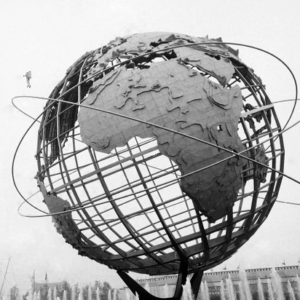 But it was the 1964 World’s Fair in New York City that ignited the American craze for these very special waffles. A vendor, Maurice Vermersch, opened a stand selling Brussels waffles filled with cream and berries that he dubbed “Bel-Gem waffles”, having decided that fairgoers were unable to spell Belgian. So popular were his waffles that a 1965 article in the Christian Science Monitor stated “Literally millions of visitors to New work have enjoyed that delectable aroma of [the Belgian] waffle crisping to a golden brown in hot ovens.”
But it was the 1964 World’s Fair in New York City that ignited the American craze for these very special waffles. A vendor, Maurice Vermersch, opened a stand selling Brussels waffles filled with cream and berries that he dubbed “Bel-Gem waffles”, having decided that fairgoers were unable to spell Belgian. So popular were his waffles that a 1965 article in the Christian Science Monitor stated “Literally millions of visitors to New work have enjoyed that delectable aroma of [the Belgian] waffle crisping to a golden brown in hot ovens.”
After the fair closed, Vermersch sold his specially designed Belgian waffle irons and recipe throughout the United States. His irons, like those of Cleyman, featured deeper recesses than American irons to allow for more rise, thus a thicker waffle.
Waffle Varieties
Fluffy, golden waffles can be found around the world in a variety of shapes, uniformity, and toppings. Here are what some of those waffles look like:
American Waffles -
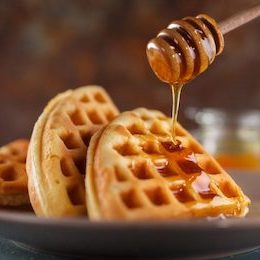 Generally thinner and more dense than Belgian waffles, they may be square, round, or rectangular. Served primarily as a breakfast or brunch food, these waffles may be topped with butter and maple syrup, pecans, chocolate chips, fruit, whipped cream or even ice cream. They are also found as a savory dish, such as fried chicken and waffles, or topped with kidney stew.
Generally thinner and more dense than Belgian waffles, they may be square, round, or rectangular. Served primarily as a breakfast or brunch food, these waffles may be topped with butter and maple syrup, pecans, chocolate chips, fruit, whipped cream or even ice cream. They are also found as a savory dish, such as fried chicken and waffles, or topped with kidney stew.
Belgian Waffles -
 These world famous waffles are actually a simplified version of the Brussels waffle. Typically leavened with baking soda, though some use yeast, Belgian waffles are thicker and lighter than their American counterpart, and served with berries and whipped cream They get their name from the Bel-Gem waffles served at the 1964 New York World’s Fair.
These world famous waffles are actually a simplified version of the Brussels waffle. Typically leavened with baking soda, though some use yeast, Belgian waffles are thicker and lighter than their American counterpart, and served with berries and whipped cream They get their name from the Bel-Gem waffles served at the 1964 New York World’s Fair.
Brussels Waffles -
Usually prepared with an egg-white or beer yeast leavening (sometimes both). They are lighter, crispier, and have larger pockets than other European varieties and are typically served warm by street vendors and dusted with powdered sugar. A variant preparation method dating back to the 18th century would be to fold whipped egg whites into the batter and cook in a large rectangular format.
Liège Waffle -
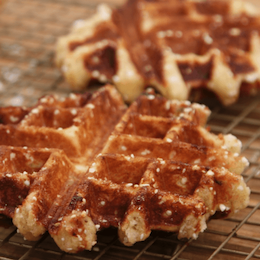 A richer, denser, sweeter and chewier waffle native to the Wallonia region of Eastern Belgium. Also known as “Hunting Waffles,” they are an adaptation of brioche bread dough with pearl sugar on the outside which caramelizes when cooked. The most common type of waffle in Belgium; sold by street vendors in plain, vanilla, and cinnamon varieties.
A richer, denser, sweeter and chewier waffle native to the Wallonia region of Eastern Belgium. Also known as “Hunting Waffles,” they are an adaptation of brioche bread dough with pearl sugar on the outside which caramelizes when cooked. The most common type of waffle in Belgium; sold by street vendors in plain, vanilla, and cinnamon varieties.
Galettes -
Another popular Belgium waffle, they are rigid and crunchy, but with a buttery, crumbly, and soft mouth-feel.
Stroopwafel -
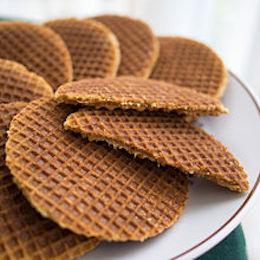 Originating in Dutch city of Gouda these big flat waffles are baked, cut in half while still warm, syrup spread on both halves and stuck together, forming a crunchy treat popular throughout the Netherlands and Belgium.
Originating in Dutch city of Gouda these big flat waffles are baked, cut in half while still warm, syrup spread on both halves and stuck together, forming a crunchy treat popular throughout the Netherlands and Belgium.
Bergische Waffles -
A specialty of the German region of Bergisches Land, these crisp waffles are always heart shaped and served with cherries, cream and optionally rice pudding as a Sunday afternoon treat in the region.
Hog Kong Style Waffles -
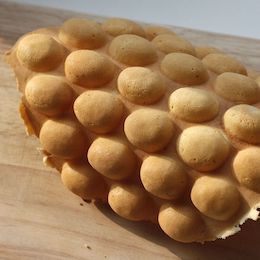 These waffles, also called “grid cakes,” are similar to a traditional waffle but softer and not dense. Traditionally sold by street vendors these sweet, round waffles are divided into four quarters, when after cooking are spread with butter, peanut butter, and sugar, then folded into a semicircle to eat.
These waffles, also called “grid cakes,” are similar to a traditional waffle but softer and not dense. Traditionally sold by street vendors these sweet, round waffles are divided into four quarters, when after cooking are spread with butter, peanut butter, and sugar, then folded into a semicircle to eat.
Another Hong Kong waffle is known as the “Bubble” or egg waffle, is a super light, doughy, and fluffy, ball usually stuffed with ice cream making it an extravagant treat.
Pandan Waffle -
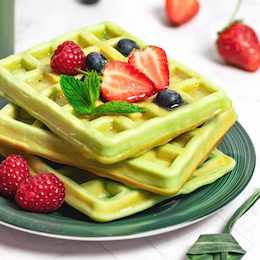 Originating in Vietnam, this waffle uses panda flavoring and coconut milk in the batter to produce a distinctive green color. When cooked the outside of the waffle is brown and crisp but the inside stays green and chewy. Pandan waffles are typically eaten plain and very popular street food among the children.
Originating in Vietnam, this waffle uses panda flavoring and coconut milk in the batter to produce a distinctive green color. When cooked the outside of the waffle is brown and crisp but the inside stays green and chewy. Pandan waffles are typically eaten plain and very popular street food among the children.
Scandinavian Style Waffles -
Common throughout the Nordic countries, these thin, round waffles are made with a batter similar to other European waffles, but contain no sugar. The most popular style are heart-shaped slices with a variety of toppings depending on which country you happen to be in.
In Norway, various cheeses and cheese spreads seem to be preferred, while the Finnish prefer jams, sugars, cream or ice cream. People of Iceland spread rhubarb or blueberry jam with whipped cream on theirs, while the Swedish enjoy strawberry, bilberry, cloudberry, raspberry jams, sugar and butter or ice cream and whipped cream on their waffles. The Swedish also like savory toppings such as salmon roe or cold-smoked salmon with cream fraiche.
Pizzelle -
 In Central Italy a waffle-like cookie made from flour, eggs, sugar, butter, and anisette are traditional. They can be hard and crisp or soft and chewy depending on the method of preparation. They can also be molded into various shapes, such as the tubular shape of cannoli. Originally made in the Abruzzo region of Italy, this is one of the oldest cookies.
In Central Italy a waffle-like cookie made from flour, eggs, sugar, butter, and anisette are traditional. They can be hard and crisp or soft and chewy depending on the method of preparation. They can also be molded into various shapes, such as the tubular shape of cannoli. Originally made in the Abruzzo region of Italy, this is one of the oldest cookies.
Gofri Waffles -
Another Italian waffle that can be found in the Piedmont region. This light and crispy textured waffle contains no eggs or milk and comes in Bothe sweet and savory versions.
Waffle Pão de Queijo -
A famous Brazilian cheese waffle made with Parigiano-Reggiano. Usually eaten as is or with a protein for dinner, these cheesy wonders can also be turned into a dessert by spreading the tops with a tasty fruit jam.
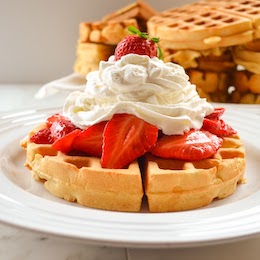 So there you have it, the wondrous world of waffles. And now you’ll have to excuse me while I run down to the kitchen and bake four or five delicious waffles for me and the family. Emmm, maybe Texas pecan, slathered with butter and drowned in Vermont maple syrup.
So there you have it, the wondrous world of waffles. And now you’ll have to excuse me while I run down to the kitchen and bake four or five delicious waffles for me and the family. Emmm, maybe Texas pecan, slathered with butter and drowned in Vermont maple syrup.

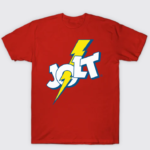

Thanks for finally writing about >The Wondrous World of Waffles – Grub
Americama <Loved it! https://Www.Waste-Ndc.pro/community/profile/tressa79906983/